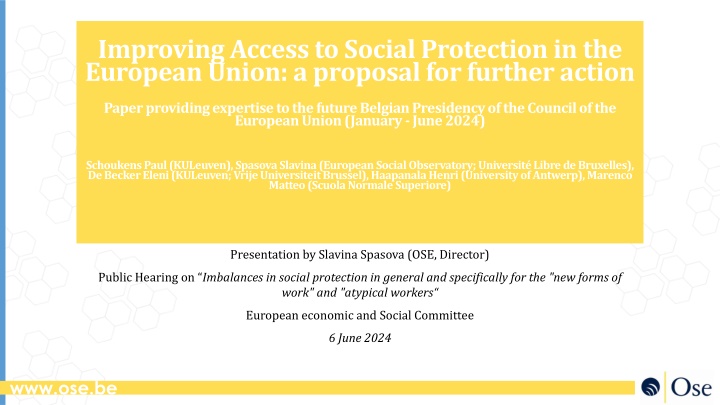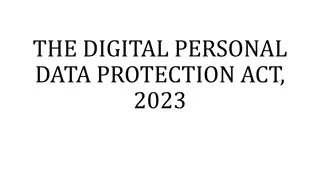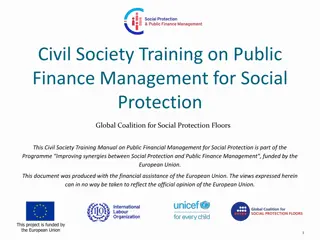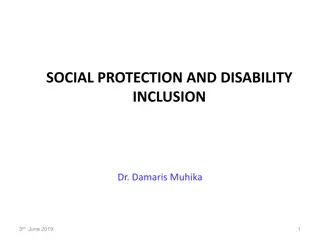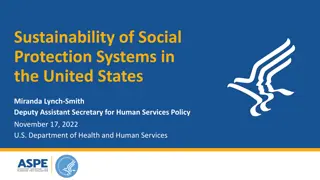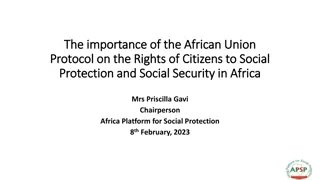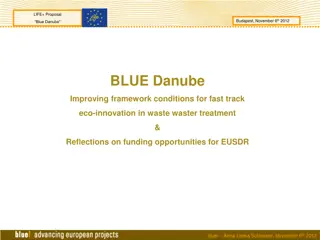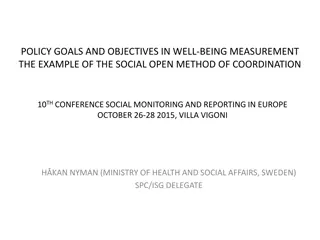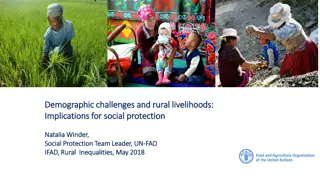Proposal for Improving Social Protection in EU
Paper presenting recommendations to enhance access to social protection in the European Union. The paper discusses monitoring frameworks, coverage adequacy, transparency, and challenges in the social protection system, focusing on new forms of work and atypical workers.
Download Presentation

Please find below an Image/Link to download the presentation.
The content on the website is provided AS IS for your information and personal use only. It may not be sold, licensed, or shared on other websites without obtaining consent from the author.If you encounter any issues during the download, it is possible that the publisher has removed the file from their server.
You are allowed to download the files provided on this website for personal or commercial use, subject to the condition that they are used lawfully. All files are the property of their respective owners.
The content on the website is provided AS IS for your information and personal use only. It may not be sold, licensed, or shared on other websites without obtaining consent from the author.
E N D
Presentation Transcript
Improving Access to Social Protection in the European Union: a proposal for further action Paper providing expertise to the future Belgian Presidency of the Council of the European Union (January -June 2024) Schoukens Paul (KULeuven), Spasova Slavina (European Social Observatory; Universit Libre de Bruxelles), De Becker Eleni (KULeuven; Vrije Universiteit Brussel), Haapanala Henri (University of Antwerp), Marenco Matteo (ScuolaNormale Superiore) Presentation by Slavina Spasova (OSE, Director) Public Hearing on Imbalances in social protection in general and specifically for the "new forms of work" and "atypical workers European economic and Social Committee 6 June 2024 www.ose.be
Table of contents 1. Further monitoring of the content of the 2019 Recommendation on access to social protection using existing legal and non-legal instruments 2. Beyond the 2019 Recommendation : Ideas for follow-up actions and instruments 3. Extending the legal basis in the EU Treaties 4. Challenges ahead www.ose.be
1. Further monitoring of the content of the 2019 Recommendation on access to social protection using existing legal and non-legal instruments (1/2) Continuation of the 2019 Recommendation monitoring framework through improved indicators Adequate coverage Further specifying the definition of adequacy within the framework of the Recommendation and in related EU policies in line with international instruments in the area Broader approach taking into account the system as a whole, i.e. minimum income moving towards a two-step identification of adequacy of social protection, including hypothetical scenarios on types of vulnerable groups and household composition Transparency of access Developing indicators on transparency as there are none www.ose.be
1. Further monitoring of the content of the 2019 Recommendation on access to social protection using existing legal and non-legal instruments (2/2) Monitoring access and adequacy through the European Semester and the EU Recovery and Resilience Facility Introducing more social recommendations, related to key gaps identified in the Recommendation and especially related to adequacy (i.e. going beyond (social) budgetary norms) Towards a balanced approach addressing financing (input) as well as adequacy (outcomes) Within the framework of the Platform work directive? Even if reclassification from self-employed to employees still issues with effective access and adequacy Possible synergies with the monitoring framework of the 2019 Recommendation www.ose.be
2. Beyond the 2019 Recommendation on access to social protection: ideas for follow-up actions and instruments (1/3) Comprehensive directive on minimum requirements ( from a Recommendation towards a Directive on minimum requirements?) Personal scope of application: binding formulation All workers and SE ; no worker/SEshall fall below ./ no one Respect for labour status neutrality protection of equal value (neutral cost hiring work) Specify which situations/grounds can justify voluntary coverage, regardless status of work Material scope Specification of the duration of benefit payment The use of minimum waiting periods and/or minimum insurance period A description of the changes required to adapt the material rules to non-standard workers The minimum provisions to be introduced at the national level to specify the rights and duties of insured persons Specific vulnerable working statuses: minimum protection guaranteed in defined cases Potentially further statutory minimum requirements in relation to the adequacy www.ose.be
2. Beyond the 2019 Recommendation on access to social protection: ideas for follow-up actions and instruments (2/3) Transparency of social protection - a separate comprehensive instrument (e.g. a recommendation or a directive) Transparency the forth pillar of the 2019 Recommendation access to information and simplification (closely related to digitalisation processes) Inclusion of several topics in relation to competence (Article 153, par. 2 (c) TFEU), as well as in relation to the use of the flexibility clauses (Articles 115 and/or 352 TFEU) Common guidelines/principles on the relations between insured persons and administrations Provision of access for citizens to clear general and personalised information on the various social statuses Simplification of administrative requirements and procedures Clarity of rules General principles on transferability of rights and entitlements Minimum requirements needed to guarantee interservice social security coordination (across the various professional systems in place) www.ose.be
2. Beyond the 2019 Recommendation on access to social protection: Ideas for follow-up actions and instruments (3/3) Job retention schemes: In-depth reviews Evidence on existing schemes A strong correlation between the design of these schemes and the actual take-up Importance of anticipating future crises and making JRS permanent An EU Recommendation on JRS ? Common understanding on design, scope and financing In which emergency situations Member States could resort to a JRS, as well as including procedures enabling Member States to fall back on EU support, thus consolidating, for instance, the existing structures developed under the SURE programme. www.ose.be
3. Extending the legal basis in the Treaty Under the hypothetical scenario of the Treaty revision: reformulate the legal basis for competence in Article 153 TFEU to include: self-employed non-economically active persons Adding to Article 153 TFEU, (c) self-employed persons after social protection and/or by adding the words of all EU citizens after social security . (i.e. usage of Articles 21 and 175 TFEU?) The specific passerelle foreseen under Article 153 TFEU could be further extended www.ose.be
4. Challenges ahead How to better include marginal non-standard workers (e.g. domestic, seasonal and other country-specific marginal workers)? Towards more universal schemes? Based on hours worked? How to better take into account the gender challenge as women are most likely to be in non-standard employment 27.8 % of employed women worked part-time versus only 7.6 % of employed men because of caring activities Indeed, more than 60 % of employed women with children worked part-time in the EU in 2022. the Gender pension gap stood as high as at 26% (2022) in the EU and 5% for men and reaches around 40% - 44% in some countries. Better provision of care credits and acknowledgement of life-events such as divorces What role for Council Directive 79/7/EEC of 19 December 1978 on the progressive implementation of the principle of equal treatment Despite its limited scope, Directive 79/7 plays an important role in the protection of atypical workers. Social security systems must demonstrate coherence and consistency ensuring that the measures and protection offered are systematically applied and consistent with the overarching objectives of social protection and non-discrimination. However, can only be applied in cases of different treatment on grounds of sex. How to link Directive 79/7 and the 2019 Recommendation on access to social protection www.ose.be
Thanks for your attention and feedback! Download the report here www.ose.be
